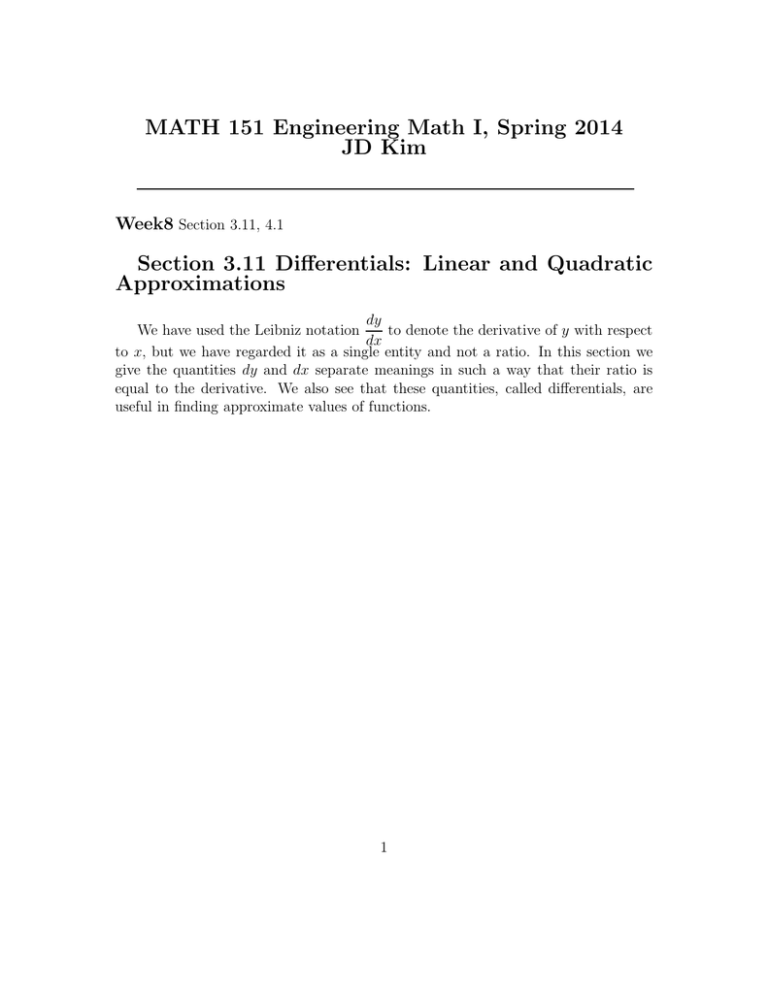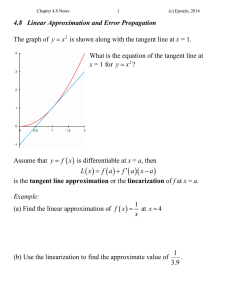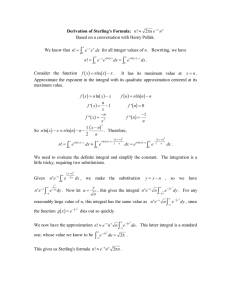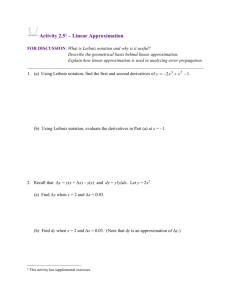MATH 151 Engineering Math I, Spring 2014 JD Kim Approximations
advertisement

MATH 151 Engineering Math I, Spring 2014
JD Kim
Week8 Section 3.11, 4.1
Section 3.11 Differentials: Linear and Quadratic
Approximations
dy
We have used the Leibniz notation
to denote the derivative of y with respect
dx
to x, but we have regarded it as a single entity and not a ratio. In this section we
give the quantities dy and dx separate meanings in such a way that their ratio is
equal to the derivative. We also see that these quantities, called differentials, are
useful in finding approximate values of functions.
1
Linear Approximation
The Linearization or Linear Approximation of f (x) at x = a is the equation
of the tangent line to the graph of f (x) at x = a, that is L(x) = f (a) + f ′ (a)(x − a).
The linear approximation can be used to approximate f for values of x near a.
Ex1) Find the linear approximation for f (x) =
1
at x = 4.
x
Ex2) Find√the linearization of the function f (x) =
approximate 36.1.
2
√
x near a = 36 and use it to
Ex3) Use a linear approximation to find an approximate value of (1.97)6 .
Ex4) Use a linear approximation to find an approximate value of cos(31.5◦).
3
Ex5) Find√the linear approximation for f (x) =
approximate 3 0.95.
√
3
x + 1 at x = 0 and use it to
Ex6) Suppose
√ that we don’t have a formula for g(x) but we know that g(2) = 4
′
and g (x) = x2 + 5 for all x. Use a linear approximation for g(x) to estimate
g(1.95) and g(2.05).
4
Ex7) Suppose for a function f , the linear approximation for f (x) at a = 3 is given
by y = 2x + 7.
7-1) Find the value of f ′ (3) and f (3).
7-2) If g(x) =
p
f (x), find the linear approximation for g(x) at a = 3.
5
Quadratic Approximations
The tangent line approximation L(x) is the best first-degree(linear) approximation to f (x) near x = a because f (x) and L(x) have the same rate of change(derivative)
at a. For a better approximation than a linear one, let’s try a second-degree(quadratic)
approximation Q(x). In other words, we approximate a curve by a parabola instead
of by a straight line.
The Quadratic Approximation for a function f (x) at x = a is
Q(x) = f (a) + f ′ (a)(x − a) +
f ′′ (a)
(x − a)2
2
Ex8) Find the quadratic approximation for f (x) = cos x at x = 0.
6
Ex9) Find the quadratic approximation to f (x) = (2x − 3)5 near a = 2 and use
it to approximation (1.08)5 .
Ex10) Suppose F and G are differentiable functions. The line y = 1 + 2x is the
tangent line approximation to F at x = 2, whereas the line y = 2 − 3x is the tangent
F
line approximation to G at x = 2. Find the tangent line approximation to H =
G
at x = 2.
7
Chapter 4. Inverse Functions: Exponential, Logarithmic, and Inverse Trigonometric Functions.
Section 4.1 Exponential Functions and Their Derivatives.
An exponential function si a function of the form
f (x) = ax
where a is a positive constant.
Five stages:
1. If x = n, a positive integer, then
an = a
| · a{z· · · a}
n factors
2. If x = 0, then
a0 = 1
3. If x = −n, n a positive integer, then
a−n =
1
an
p
4. If x is a rational number, x = , where p and q are integers and q > 0, then
q
√
ax = ap/q = q ap
5. If x is an irrational number, we wish to define ax so as to fill in the holes of
the graph of the function y = ax , where x is rational. In other words, we want
to make f (x) = ax , x ∈ R, a continuous function. Since any irrational number
can be approximated as closely as we like by a rational number, we define
ax = lim ar , r rational
r→x
8
Law of Exponents
If a > 0 and a 6= 1, then f (x) = ax is a continuous function with domain R and
range (0, ∞). In particular, ax > 0 for all x.
If 0 < a < 1, f (x) = ax is a decreasing function; if a > 1, f is increasing function.
If a, b > 0, and x, y ∈ R, then
1. ax+y = ax ay
2. ax−y =
ax
ay
3. (ax )y = axy
4. (ab)x = ax bx
Exponential Growth
If a > 1, then f (x) = ax grows exponentially;
Exponential Decay
If 0 < a < 1, then f (x) = ax decay exponentially;
9
Ex11) Sketch the graph of f (x) = 2x and g(x) = 3x on the same axis.
x
1
− 4 using transformations of graphs.
Ex12) Sketch the graph of f (x) =
2
Exponent Function
We call f (x) = ex the exponential function, where e ≈ 2.718281828. One interesting fact about f (x) = ex is that it is the only exponential function where the slope
of tangent line at x = 0 is 1.
10
Ex13) Find the limit;
13-1) limx→∞ (0.3)−x
13-2) limx→−∞ (0.3)−x
x
1 2−x
13-3) limx→2+
4
x
1 2−x
13-4) limx→2−
4
2
13-5) limx→1− e x − 1
2
13-6) limx→1+ e x − 1
11
13-7) limx→∞
ex − e−3x
e3x + e−3x
13-8) limx→−∞
2−x + 2x
4−x + 3x
Derivatives of Exponential Functions
1.
2.
d x
e = ex
dx
d f (x)
e
= ef (x) · f ′ (x)
dx
12
Ex14) Find the derivative:
14-1) y = e4x
14-2) y = e−5x
14-3) y =
√
ex + x +
1
+ xe
e
14-4) f (x) = ex sin x
Ex15) Find the equation of the tangent line to the graph of 2exy = x + y at the
point (0, 2).
13
Ex16) For what value(s) of r does y = erx satisfy y + y ′ = y ′′?
Ex17) Find the equation of the tangent line to the parametric curve x = e−t , y =
te at t = 0.
2t
Ex18) Find the derivative of f (x) = g(ex ) + eg(sin x) .
14





